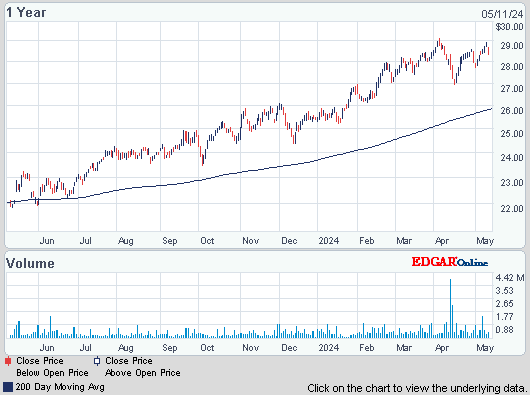Dow inched up 5, advancers barely ahead of decliners & NAZ was up 2. The Financial Index was up a fraction in the 246s (just below last week's post Lehman collapse high). The MLP index fell almost 2 to the 434s & the REIT index was up pennies in the 282s. Junk bond funds pulled back & Treasuries were flattish. Oil slid lower & gold fell, ending the longest rally
since Aug, as stronger data in the US eased pressure on the
Federal Reserve to expand its stimulus measures to boost growth.
AMJ (Alerian MLP Index tracking fund)

![Live 24 hours gold chart [Kitco Inc.]](http://www.kitco.com/images/live/gold.gif)


Photo: Bloomberg
Europe may contract 1-1½% in the next 12 months with the private sector unable to borrow & austerity policies limiting growth, according to Pimco’s Mohamed El-Erian. “The private sector is still starved for credit,” El- Erian, the CEO of the world’s largest manager of bond funds, said. “Given the austerity in place, the economy will contract, which is bad for unemployment, especially youth unemployment.” Pimco’s recession forecast is deeper than the official ECB estimate, which the central bank revised lower at last week’s policy meeting when it said the economy will contract 0.5% this year instead of the 0.3% projected 3 months ago, with ECB President Draghi blaming an overhang from the bigger shrinkage in Q4-2012. Ireland’s first sale of 10-year gov bonds today (since the nation’s 2010 bailout) is a sign of the gradual healing in Europe’s financial sector, El-Erian said. Ireland had made structural reforms such as nationalizing banks that must be embraced by the rest of Europe, he added. Its Dublin-based debt agency increased the planned sale of bonds to €5B ($6.5B), in its first 10-year debt issue since the intl rescue. The agency had planned to sell about €3B of bonds.
The US federal budget deficit jumped in Feb from Jan, though it is still running below last year's pace. Higher taxes & an improving economy are expected to hold the deficit below $1T (that's not saying much) for the first time since Obama took office. The Treasury Dept said the deficit grew in Feb $203.5B, following a small surplus of $2.9B in Jan, & the gap was $28B smaller than the same month a year ago. Thru the first 5 months of the budget year that began on Oct 1, the deficit is $494B, nearly $87B lower than the gap for the same period a year ago. The CBO estimates the deficit will total $845B for the entire year, down from $1.1T in the 2012 budget year & the lowest since 2008. Even with the improvement, the gov would be required to borrow 24¢ of every dollar it spends this year. The CBO's estimate doesn't reflect the $44B of across-the-board spending cuts that kicked in Mar 1. Those cuts many reduce the deficit by about 5%. Higher Social Security taxes have contributed to a smaller deficit. The tax on nearly all Americans increased revenue in Feb by $8B & the tax increase is projected to raise about $10B more a month in revenue for the rest of the budget year. Another factor reducing the budget gap has been a delay in tax refunds. The IRS delayed processing the refunds by 2 weeks this year because final tax rates weren't settled until Jan 1. As a result, tax refunds were $20B lower in Jan & Feb than the same 2 months last year. Modest economic growth has boosted federal tax receipts.
House Reps & Senate Dems are rolling out their budget proposals this week as the 2 political parties lay down markers for what is expected to be a prolonged fight over taxes & spending. But the pres has not yet released his budget proposal (likely in early Apr). Legislation passed by congress over the past 2 years will reduce deficits by roughly $2.4T over the next decade, 2/3 from spending cuts & the balance from more taxes. All the plans, however, would replace recently enacted across-the-board spending cuts with cuts that are more targeted.
House Republican plan:
(1) Cuts spending by $4.6T over the next decade, balancing the budget by 2023 with no tax increases.
(2) Entitlements: Replaces traditional Medicare for people now under 55 with a gov subsidy to buy health insurance on the open market, & calls on both the pres & Congress to address Social Security without offering specifics. The plan would repeal Obamacare but preserve more than $700B in the health care law's cuts to Medicare providers over a decade.
(3) Taxes: Calls for an overhaul of the tax code but does not increase revenue, except thru economic growth. The plan incorporates more than $600B in tax increase enacted in Jan.
Senate Democratic plan:
(1) Reduces gov borrowing by $1.85T over the next decade with roughly equal amounts of spending cuts & tax increases; does not produce a balanced budget.
(2) Entitlements: Includes $275B in cuts to Medicare providers over the next decade but does not cut benefits.
(3) Taxes: Calls for an overhaul of the tax code that generates $975B in additional revenue over the next decade by "closing loopholes" in the tax code that benefit wealthy Americans & big corps.
How competing budget proposals line up AP
The lines have been drawn over the budget battle, with no great surprises. Reps are talking about balancing the budget with targeted spending cuts. Dems have vague spending reductions & hope that higher taxes on the rich will close the fiscal hole, eventually. It's not hard to figure out how where the pres will come down on this fight. These 2 plans have fundamental differences & it's difficult to imagine how the 2 sides will be able to compromise. Early signals indicate that business during Feb in the US was reasonably good which is keeping the bulls happy. Dow rose all of 8 (total) in the last 2 days, good enough for 2 record closes & is on a 9 day winning streak. That can not last.
AMJ (Alerian MLP Index tracking fund)
Treasury yields:
U.S. 3-month |
0.089% | |
U.S. 2-year |
0.260% | |
U.S. 10-year |
2.020% |
| CLJ13.NYM | ...Crude Oil Apr 13 | ...92.39 | ... | (0.2%) |
![Live 24 hours gold chart [Kitco Inc.]](http://www.kitco.com/images/live/gold.gif)


Photo: Bloomberg
Europe may contract 1-1½% in the next 12 months with the private sector unable to borrow & austerity policies limiting growth, according to Pimco’s Mohamed El-Erian. “The private sector is still starved for credit,” El- Erian, the CEO of the world’s largest manager of bond funds, said. “Given the austerity in place, the economy will contract, which is bad for unemployment, especially youth unemployment.” Pimco’s recession forecast is deeper than the official ECB estimate, which the central bank revised lower at last week’s policy meeting when it said the economy will contract 0.5% this year instead of the 0.3% projected 3 months ago, with ECB President Draghi blaming an overhang from the bigger shrinkage in Q4-2012. Ireland’s first sale of 10-year gov bonds today (since the nation’s 2010 bailout) is a sign of the gradual healing in Europe’s financial sector, El-Erian said. Ireland had made structural reforms such as nationalizing banks that must be embraced by the rest of Europe, he added. Its Dublin-based debt agency increased the planned sale of bonds to €5B ($6.5B), in its first 10-year debt issue since the intl rescue. The agency had planned to sell about €3B of bonds.
Europe to Contract as Much as 1.5%, El-Erian Says: Tom Keene
The US federal budget deficit jumped in Feb from Jan, though it is still running below last year's pace. Higher taxes & an improving economy are expected to hold the deficit below $1T (that's not saying much) for the first time since Obama took office. The Treasury Dept said the deficit grew in Feb $203.5B, following a small surplus of $2.9B in Jan, & the gap was $28B smaller than the same month a year ago. Thru the first 5 months of the budget year that began on Oct 1, the deficit is $494B, nearly $87B lower than the gap for the same period a year ago. The CBO estimates the deficit will total $845B for the entire year, down from $1.1T in the 2012 budget year & the lowest since 2008. Even with the improvement, the gov would be required to borrow 24¢ of every dollar it spends this year. The CBO's estimate doesn't reflect the $44B of across-the-board spending cuts that kicked in Mar 1. Those cuts many reduce the deficit by about 5%. Higher Social Security taxes have contributed to a smaller deficit. The tax on nearly all Americans increased revenue in Feb by $8B & the tax increase is projected to raise about $10B more a month in revenue for the rest of the budget year. Another factor reducing the budget gap has been a delay in tax refunds. The IRS delayed processing the refunds by 2 weeks this year because final tax rates weren't settled until Jan 1. As a result, tax refunds were $20B lower in Jan & Feb than the same 2 months last year. Modest economic growth has boosted federal tax receipts.
House Reps & Senate Dems are rolling out their budget proposals this week as the 2 political parties lay down markers for what is expected to be a prolonged fight over taxes & spending. But the pres has not yet released his budget proposal (likely in early Apr). Legislation passed by congress over the past 2 years will reduce deficits by roughly $2.4T over the next decade, 2/3 from spending cuts & the balance from more taxes. All the plans, however, would replace recently enacted across-the-board spending cuts with cuts that are more targeted.
House Republican plan:
(1) Cuts spending by $4.6T over the next decade, balancing the budget by 2023 with no tax increases.
(2) Entitlements: Replaces traditional Medicare for people now under 55 with a gov subsidy to buy health insurance on the open market, & calls on both the pres & Congress to address Social Security without offering specifics. The plan would repeal Obamacare but preserve more than $700B in the health care law's cuts to Medicare providers over a decade.
(3) Taxes: Calls for an overhaul of the tax code but does not increase revenue, except thru economic growth. The plan incorporates more than $600B in tax increase enacted in Jan.
Senate Democratic plan:
(1) Reduces gov borrowing by $1.85T over the next decade with roughly equal amounts of spending cuts & tax increases; does not produce a balanced budget.
(2) Entitlements: Includes $275B in cuts to Medicare providers over the next decade but does not cut benefits.
(3) Taxes: Calls for an overhaul of the tax code that generates $975B in additional revenue over the next decade by "closing loopholes" in the tax code that benefit wealthy Americans & big corps.
How competing budget proposals line up AP
The lines have been drawn over the budget battle, with no great surprises. Reps are talking about balancing the budget with targeted spending cuts. Dems have vague spending reductions & hope that higher taxes on the rich will close the fiscal hole, eventually. It's not hard to figure out how where the pres will come down on this fight. These 2 plans have fundamental differences & it's difficult to imagine how the 2 sides will be able to compromise. Early signals indicate that business during Feb in the US was reasonably good which is keeping the bulls happy. Dow rose all of 8 (total) in the last 2 days, good enough for 2 record closes & is on a 9 day winning streak. That can not last.











No comments:
Post a Comment